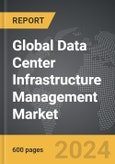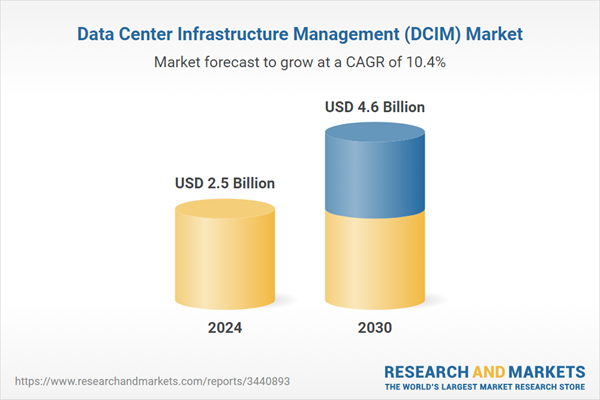The global market for Data Center Infrastructure Management (DCIM) was valued at US$2.5 Billion in 2024 and is projected to reach US$4.6 Billion by 2030, growing at a CAGR of 10.4% from 2024 to 2030. This comprehensive report provides an in-depth analysis of market trends, drivers, and forecasts, helping you make informed business decisions. The report includes the most recent global tariff developments and how they impact the Data Center Infrastructure Management (DCIM) market.
In recent years, the importance of DCIM has grown significantly due to the increasing complexity and scale of data centers. With the rise of cloud computing, big data analytics, and the Internet of Things (IoT), data centers are now handling unprecedented volumes of data and require sophisticated management tools to maintain performance and reliability. Modern DCIM solutions incorporate advanced technologies such as artificial intelligence (AI) and machine learning (ML) to predict potential failures, optimize energy consumption, and automate routine tasks. For instance, AI-driven analytics can forecast cooling requirements based on historical data and current operating conditions, thereby preventing overheating and reducing energy costs. Additionally, the integration of DCIM with virtualization and software-defined infrastructure allows for more flexible and efficient resource management, aligning data center operations with dynamic business needs.
The growth in the DCIM market is driven by several factors, including technological advancements, increasing data center complexity, and rising demand for energy efficiency. As data centers become more critical to business operations, the need for robust DCIM solutions that can manage diverse and complex environments has intensified. Technological innovations, such as AI and ML, are enhancing the capabilities of DCIM tools, making them more predictive and adaptive. Furthermore, the growing emphasis on sustainability and energy efficiency is pushing data centers to adopt DCIM solutions that can help reduce their carbon footprint and operational costs. Regulatory pressures and industry standards related to energy usage and environmental impact are also encouraging the adoption of DCIM. Additionally, the proliferation of edge computing and distributed data centers is creating new challenges that require sophisticated management tools, further driving the demand for DCIM. As these factors converge, the DCIM market is poised for robust growth, fueled by the need for enhanced operational efficiency, technological innovation, and sustainable data center practices.
Segments: Component (Solutions, Services); Application (Asset Management, Capacity Planning, Power Monitoring, Environmental Monitoring, Other Applications); Vertical (BFSI, Manufacturing, IT & ITeS, Telecommunications, Healthcare & Life Sciences, Other Verticals).
Geographic Regions/Countries: World; USA; Canada; Japan; China; Europe; France; Germany; Italy; UK; Spain; Russia; Rest of Europe; Asia-Pacific; Australia; India; South Korea; Rest of Asia-Pacific; Latin America; Argentina; Brazil; Mexico; Rest of Latin America; Middle East; Iran; Israel; Saudi Arabia; UAE; Rest of Middle East; Africa.
The analysts continuously track trade developments worldwide, drawing insights from leading global economists and over 200 industry and policy institutions, including think tanks, trade organizations, and national economic advisory bodies. This intelligence is integrated into forecasting models to provide timely, data-driven analysis of emerging risks and opportunities.
Global Data Center Infrastructure Management (DCIM) Market - Key Trends & Drivers Summarized
Data Center Infrastructure Management (DCIM) encompasses a suite of tools and methodologies designed to manage and optimize the physical and logical components of a data center. These systems integrate information technology (IT) and facility management disciplines to provide a holistic view of a data center's performance, including power usage, cooling efficiency, and space utilization. DCIM solutions offer real-time monitoring, asset management, and predictive analytics, enabling data center operators to improve efficiency, reduce costs, and enhance operational reliability. By consolidating data from various sources, DCIM provides actionable insights that help in identifying inefficiencies, planning for capacity expansion, and ensuring that resources are used optimally.In recent years, the importance of DCIM has grown significantly due to the increasing complexity and scale of data centers. With the rise of cloud computing, big data analytics, and the Internet of Things (IoT), data centers are now handling unprecedented volumes of data and require sophisticated management tools to maintain performance and reliability. Modern DCIM solutions incorporate advanced technologies such as artificial intelligence (AI) and machine learning (ML) to predict potential failures, optimize energy consumption, and automate routine tasks. For instance, AI-driven analytics can forecast cooling requirements based on historical data and current operating conditions, thereby preventing overheating and reducing energy costs. Additionally, the integration of DCIM with virtualization and software-defined infrastructure allows for more flexible and efficient resource management, aligning data center operations with dynamic business needs.
The growth in the DCIM market is driven by several factors, including technological advancements, increasing data center complexity, and rising demand for energy efficiency. As data centers become more critical to business operations, the need for robust DCIM solutions that can manage diverse and complex environments has intensified. Technological innovations, such as AI and ML, are enhancing the capabilities of DCIM tools, making them more predictive and adaptive. Furthermore, the growing emphasis on sustainability and energy efficiency is pushing data centers to adopt DCIM solutions that can help reduce their carbon footprint and operational costs. Regulatory pressures and industry standards related to energy usage and environmental impact are also encouraging the adoption of DCIM. Additionally, the proliferation of edge computing and distributed data centers is creating new challenges that require sophisticated management tools, further driving the demand for DCIM. As these factors converge, the DCIM market is poised for robust growth, fueled by the need for enhanced operational efficiency, technological innovation, and sustainable data center practices.
Report Scope
The report analyzes the Data Center Infrastructure Management (DCIM) market, presented in terms of units. The analysis covers the key segments and geographic regions outlined below.Segments: Component (Solutions, Services); Application (Asset Management, Capacity Planning, Power Monitoring, Environmental Monitoring, Other Applications); Vertical (BFSI, Manufacturing, IT & ITeS, Telecommunications, Healthcare & Life Sciences, Other Verticals).
Geographic Regions/Countries: World; USA; Canada; Japan; China; Europe; France; Germany; Italy; UK; Spain; Russia; Rest of Europe; Asia-Pacific; Australia; India; South Korea; Rest of Asia-Pacific; Latin America; Argentina; Brazil; Mexico; Rest of Latin America; Middle East; Iran; Israel; Saudi Arabia; UAE; Rest of Middle East; Africa.
Key Insights:
- Market Growth: Understand the significant growth trajectory of the Solutions segment, which is expected to reach US$3.1 Billion by 2030 with a CAGR of a 10.3%. The Services segment is also set to grow at 10.8% CAGR over the analysis period.
- Regional Analysis: Gain insights into the U.S. market, valued at $1.4 Billion in 2024, and China, forecasted to grow at an impressive 16.3% CAGR to reach $359.9 Million by 2030. Discover growth trends in other key regions, including Japan, Canada, Germany, and the Asia-Pacific.
Why You Should Buy This Report:
- Detailed Market Analysis: Access a thorough analysis of the Global Data Center Infrastructure Management (DCIM) Market, covering all major geographic regions and market segments.
- Competitive Insights: Get an overview of the competitive landscape, including the market presence of major players across different geographies.
- Future Trends and Drivers: Understand the key trends and drivers shaping the future of the Global Data Center Infrastructure Management (DCIM) Market.
- Actionable Insights: Benefit from actionable insights that can help you identify new revenue opportunities and make strategic business decisions.
Key Questions Answered:
- How is the Global Data Center Infrastructure Management (DCIM) Market expected to evolve by 2030?
- What are the main drivers and restraints affecting the market?
- Which market segments will grow the most over the forecast period?
- How will market shares for different regions and segments change by 2030?
- Who are the leading players in the market, and what are their prospects?
Report Features:
- Comprehensive Market Data: Independent analysis of annual sales and market forecasts in US$ Million from 2024 to 2030.
- In-Depth Regional Analysis: Detailed insights into key markets, including the U.S., China, Japan, Canada, Europe, Asia-Pacific, Latin America, Middle East, and Africa.
- Company Profiles: Coverage of players such as Cisco Systems, Inc., Huawei Technologies Co., Ltd., Google LLC, ABB Ltd., Eaton Corporation PLC and more.
- Complimentary Updates: Receive free report updates for one year to keep you informed of the latest market developments.
Some of the 77 companies featured in this Data Center Infrastructure Management (DCIM) market report include:
- Cisco Systems, Inc.
- Huawei Technologies Co., Ltd.
- Google LLC
- ABB Ltd.
- Eaton Corporation PLC
- HCL Technologies Ltd.
- Atos SE
- CommScope, Inc.
- Amada Co., Ltd.
- Digital Realty Trust, Inc.
- 2BM
- Hewlett Packard Enterprise Development LP (HPE)
- Critical Environments Group
- Green Revolution Cooling Inc. (GRC)
- Conteg
Tariff Impact Analysis: Key Insights for 2025
Global tariff negotiations across 180+ countries are reshaping supply chains, costs, and competitiveness. This report reflects the latest developments as of April 2025 and incorporates forward-looking insights into the market outlook.The analysts continuously track trade developments worldwide, drawing insights from leading global economists and over 200 industry and policy institutions, including think tanks, trade organizations, and national economic advisory bodies. This intelligence is integrated into forecasting models to provide timely, data-driven analysis of emerging risks and opportunities.
What’s Included in This Edition:
- Tariff-adjusted market forecasts by region and segment
- Analysis of cost and supply chain implications by sourcing and trade exposure
- Strategic insights into geographic shifts
Buyers receive a free July 2025 update with:
- Finalized tariff impacts and new trade agreement effects
- Updated projections reflecting global sourcing and cost shifts
- Expanded country-specific coverage across the industry
Table of Contents
I. METHODOLOGYII. EXECUTIVE SUMMARY2. FOCUS ON SELECT PLAYERSIII. MARKET ANALYSISCANADAITALYSPAINRUSSIAREST OF EUROPESOUTH KOREAREST OF ASIA-PACIFICBRAZILMEXICOREST OF LATIN AMERICAIV. COMPETITION
1. MARKET OVERVIEW
3. MARKET TRENDS & DRIVERS
4. GLOBAL MARKET PERSPECTIVE
UNITED STATES
JAPAN
CHINA
EUROPE
FRANCE
GERMANY
UNITED KINGDOM
ASIA-PACIFIC
AUSTRALIA
INDIA
LATIN AMERICA
MIDDLE EAST
AFRICA
Companies Mentioned (Partial List)
A selection of companies mentioned in this report includes, but is not limited to:
- Cisco Systems, Inc.
- Huawei Technologies Co., Ltd.
- Google LLC
- ABB Ltd.
- Eaton Corporation PLC
- HCL Technologies Ltd.
- Atos SE
- CommScope, Inc.
- Amada Co., Ltd.
- Digital Realty Trust, Inc.
- 2BM
- Hewlett Packard Enterprise Development LP (HPE)
- Critical Environments Group
- Green Revolution Cooling Inc. (GRC)
- Conteg
Table Information
| Report Attribute | Details |
|---|---|
| No. of Pages | 600 |
| Published | April 2025 |
| Forecast Period | 2024 - 2030 |
| Estimated Market Value ( USD | $ 2.5 Billion |
| Forecasted Market Value ( USD | $ 4.6 Billion |
| Compound Annual Growth Rate | 10.4% |
| Regions Covered | Global |









